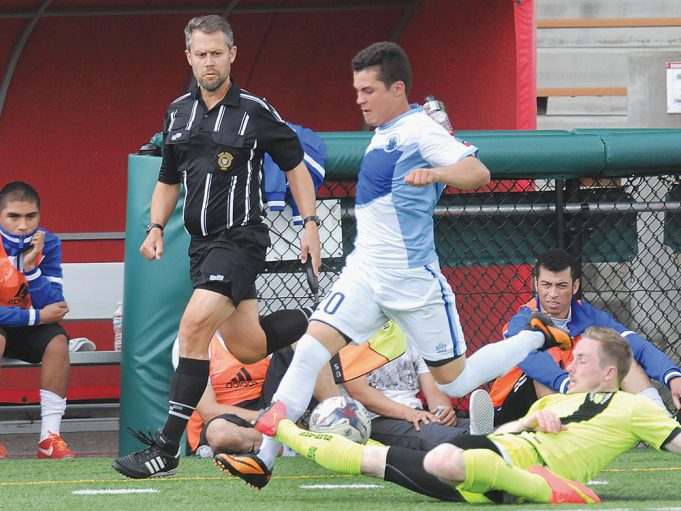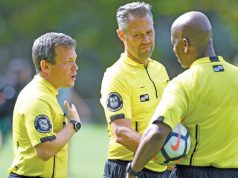National Soccer Hall of Famer Alfred Kleinaitis spoke on the match responsibilities of assistant referees at an Elite Clubs National League event in San Diego some years ago.
He started his speech by saying, “The assistant referee needs to get the rhythm of the game.” My words, not his, explain what followed.
The referee sets the tone for what should be allowed and what will be called, but he also is always adjusting to the flow of the game. The assistant referees need to understand what the referee is doing before they can provide useful assistance. Assistant referees need to call the referee’s game. They need to get into the referee’s rhythm.
At a symphony, the musicians have to adjust to the conductor’s rhythm to perform as a team. They start at rehearsal, talking about things that matter. Our rehearsal is the pregame. It is our chance to talk about expectations for the match, and how the team can best help the referee. During the performance, the musicians can watch the conductor’s gestures. During the match, the ARs need to watch what the referee is doing and why.
Assistant referees need to follow the referee’s lead. Kleinaitis noted how that can be hard to do when focused on the offside line or on players off the ball. So, the ARs need to widen their field of vision. He suggested to “step back a yard from the touchline.” From there, the ARs can see the ball, the referee and the second-last defender.
That also means that the referee’s job is not just to set the bar or to communicate with the players. The referee needs to be clear in communicating to the ARs whether inaction is the result of a “wait and see,” deciding that the event was not an offense, or is not a decision at all because it is something that he or she didn’t see. When the referee decides to tighten or loosen the flow, the referee’s task is to act so that the ARs understand when it changes. The referee will adjust the tempo, but the ARs need to know when that happens.
The referee can identify the tone during the pregame. What are the referee’s expectations regarding the speed and temperature of today’s match? How will the referee convey information about what should be called or ignored? Does the referee point at contact that has been seen, but judged to be trifling or a fair challenge? Will the referee use a hard stare at the ARs to indicate when they should confirm or add information about a play? How does the referee indicate that the flow of the match needs to be tightened up?
During the match, it is not enough for the ARs to be aware of what the players are doing. They need to be aware of how the referee is responding to what the players are doing. When possible, the ARs should allow the referee to set the tone by not being the first to call a foul. Moreover, the ARs need to search for clues from the referee on what he or she is allowing. Is the referee urging the players to continue? Is he or she warning players or telling them to remain “steady”? Or is the referee less verbal? Of course, the clearest clue is a verbal and visual award of advantage. When the referee uses the correct advantage mechanic, the ARs know that the referee saw it, considered it a foul, but is allowing play to continue. The referee, however, needs to communicate just as clearly other clues about the rhythm of the game to the ARs.
One tip from a USSF National Assessor: The AR should silently make a mental note each time the referee calls a foul or warns/cautions of the number of both players involved and of their jersey color. Noting “red six against white two” helps the AR focus on what the referee is calling today, and to be prepared for the next engagement between the two players.
Just when the ARs have a clear understanding of how the referee plans to call the game, things can change. A substitute’s desire to prove he or she should be a starter may incite conflict. An easy game suddenly becomes a challenge and temperatures rise. Conversely, good players can adjust to how the referee has set the bar, and the referee can allow the match to become fast and entertaining. The wise referee adjusts the flow of the match to meet the changing conditions of the match.
The ARs need to know when those changes happen and adjust as well. Their skill in reading players can identify when the players are (or are not) responding to the referee’s rhythm. So armed, the ARs can anticipate how the referee will adjust the flow of the game. The adjustments commonly arise in the last 10 minutes of the first half, the first 10 minutes of the second half and again in the last 10 minutes of the match. During those periods, the AR must pay closer attention to any adjustments that the referee makes.
The ARs’ job can be harder than the referee’s, Kleinaitis explained. It is much easier to make a judgment based on your own perceptions and values than to use someone else’s. But it is the referee’s judgment that matters. To assist the referee, the AR needs to provide more than just raw information, but information that is tailored to be useful to how the referee has set the tone and flow of the match. Eye contact with the referee will usually inform the AR when the referee is looking for input. Providing information the referee doesn’t want and doesn’t need is insisting rather than assisting.
Sometimes the referee makes a call that the AR would not have chosen if the roles were reversed. But any action by the AR, every flag signal, should be viewed as a recommendation, not a judgment. The challenge is to understand when the referee lacks the information to make the best decision. Observing the referee and understanding what the referee is calling (or deciding is trifling and worthy of no whistle) will help the ARs gauge when to provide those facts.
What if the referee is misapplying the Laws or rules? The entire referee team has the responsibility to prevent that from happening. If the AR is certain that the restart is incorrect — that a player has not been sent off after a second caution or the referee has misapplied the Laws or rules in another match-critical event — the AR must get the referee’s attention. A private chat can identify the correct action the referee should take. But even then, the ultimate judgment belongs to the referee.
The officiating team loses when the AR has information on a match-critical event but does not convey it. The official’s team equally loses when the ARs’ actions disrupt the referee’s rhythm of the game.
What's Your Call? Leave a Comment:
Note: This article is archival in nature. Rules, interpretations, mechanics, philosophies and other information may or may not be correct for the current year.
This article is the copyright of ©Referee Enterprises, Inc., and may not be republished in whole or in part online, in print or in any capacity without expressed written permission from Referee. The article is made available for educational use by individuals.


















